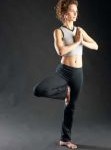
Recently, there was a discussion related to the importance of anatomy in a Yoga teacher training course. Some teachers are taking anatomy courses for the sake of continuing education, but they don’t know why. When considering teaching Hatha Yoga, we should design our classes to be as safe as possible for each student.
This is the main purpose for pursuing knowledge in relation to Hatha Yoga and anatomy. Granted, Hatha Yoga is much more than a physical exercise class; but teachers should be aware of contraindications, faulty alignment, and unsafe practices that have been going on for centuries.
One example would be Tree Pose. How often have you seen a picture of a group of Yoga students, with one foot placed against the inside knee of the balancing leg? All you have to do is visit a few different Yoga web sites, and you will see a similar photograph.
Placing pressure against the side of the knee is unwise and invites injury. If pressure is applied with the foot that is against the inside knee, of the balancing leg, this can push your knee out of alignment while your knee is trying to bear the weight of your entire body.
Add to this fact, that a new student may have a pre-existing knee injury. In such a case, a Yoga teacher would want to help a student avoid making a bad situation worse. Students are supposed to feel better after the class – than they did when walking into the class.
During an anatomy for Yoga class, one learns that the knee is a hinge joint. It is not made to take weight, or pressure, from the side. For that matter, the knee is really not designed to take much pressure from any direction. It is also not designed to rotate in circles.
This is the type of knowledge, which is discussed within Yoga anatomy courses. The purpose is to make our Hatha Yoga classes safe for our students. It should be noted that those, who become proficient in anatomical jargon, share their knowledge, with their students, in an easy-to-understand manner. The reason is that, dedicated students will practice, independently, and should know how to avoid injuries.
Yoga anatomy not only applies to asana, but also applies to pranayama and bandha techniques. It goes without saying that bandha, or pranayama, practiced unsafely can cause harm to a Yoga practitioner.
© Copyright 2010 – Paul Jerard / Aura Publications
See our testimonials to find out what our graduates have to say about teaching yoga classes and our selection of affordable online yoga teacher certification intensives.
If you are a teacher, yoga school manager, blogger, e-zine, or website publisher, and are in need of quality content, please feel free to use my blog entries (articles). Please be sure to reprint each article, as is. Namaste!

Leave A Comment
You must be logged in to post a comment.